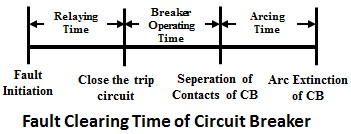The circuit breaker is an important component of the power system. It is used for the protection of each and every electrical component from faults. Hence the circuit breaker used must have the capability of protecting the system against faults without damaging itself. A circuit breaker used should extinguish the arc produced between its contacts due to fault current at the time of circuit interruption.
The arc produced in a circuit breaker is a type of electric discharge that provides a path for current flow even though the contacts are separated. This causes damage to the equipment which are to be protected.
Also, if the arc is not extinguished it may result in an explosion. Hence the circuit breaker must extinguish the arc generated at the time of fault current interruption. The following terms are used during the analysis of circuit breaker,
Arc Voltage :
Arc voltage is the voltage that is responsible for maintaining the arc between the contacts of the circuit breaker. At the time of circuit breaker contacts opening, an arc is struck between the contacts due to ionization of medium surrounding the contacts. A small potential difference exists between the contacts and it is responsible for maintaining the arc. This voltage is called the Arc Voltage.
Restriking Voltage :
Whenever arc interruption occurs at zero current instant, the voltage across the circuit breaker gap will suddenly rise from zero to a very high value. This high voltage will be transient in nature.
The transient voltage that appears across the circuit breaker contacts immediately after the arc extinction or at current zero during the arcing period is called Restriking Voltage.
This voltage is so named because the arc can restrike only during the existence period of this transient voltage. If the arc does not restrike during this transient period, it will not restrike later. This restriking voltage is also known as Transient Recovery Voltage.
Recovery Voltage :
It is defined as the voltage appearing across the circuit breaker contacts after the final arc extinction and after all the transients die out (or disappears). The frequency of recovery voltage is the same as the supply frequency.
Consider a circuit breaker whose contacts are opened, then the fault current drops to zero. At zero current instant, no ions are present in the gap between the contacts. At this condition, the dielectric strength of the medium (air or oil) between the contacts will be high, which is strong enough to avoid the breakdown by the restriking voltage. As a result the final arc extinction takes place and circuit current is interrupted.
As soon as the current is interrupted after the final arc extinction, the voltage appears across the circuit breaker contacts, which has a transient part. Therefore, the voltage appearing across the circuit breaker contacts after all transient oscillations die out or disappear is known as recovery voltage. This voltage is of normal frequency RMS voltage which is approximately equal to the system voltage.
The waveforms of arc voltage, recovery voltage and restriking voltage are shown above. From the waveform, it can be seen that restriking voltage and recovery voltage are simply the voltage across the circuit breaker contacts. The only difference between them is their period of existence.
Fault Clearing Time :
Whenever a fault (short-circuit fault) occurs, the current rises to a very high value and the voltage falls to a low value. These abnormal conditions are sensed by the relays connected in secondaries of CTs and/or PTs.
As the corresponding quantities go beyond their prescribed limits, the relay receives its actuating amount of the corresponding quantity. The moving system of the relay starts moving as it receives sufficient operating torque. The moving system finally closes the trip circuit of the circuit breaker.
The trip coil of the circuit breaker will be energized and so the circuit breaker opens its contact. Obviously, an arc will appear between the contacts. The voltage across the circuit breaker contacts (i.e., arc voltage) will be quite small and will be in phase with the arc current. The arc will be extinguished using suitable techniques at zero current instant.
- Time from fault initiation to close the trip circuit of the circuit breaker is called relaying time.
- Time from the closure of the contacts of the trip circuit to the separation of the circuit breaker contacts is called breaker operating time.
- Time from contact separation of the circuit breaker to the arc extinction of the circuit breaker is called arcing time.
The sum of relaying time, breaker operating time, and arcing time is called fault clearing time.


